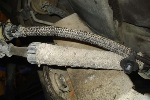Just got my (original) radiator replaced during the last couple days. I finished it yesterday. I did it in my garage with normal hand tools. Took about 5 hours total, including frequent breaks to chill down indoors. (It was nearly 100F here, and the garage certainly was hotter than that!)
As most I was not able to release the trans cooler lines, even when I had the Lisle tool. I unscrewed the connectors and used them with new rad. Luckily the $88 ebay radiator (brand seems to be Sunbelt) had exactly the same fittings. I lost maybe a cup of tranny fluid.
The radiator itself wasn't too difficult to remove and put new one in. Based on the stories here I was expecting more trouble...
By quick look at the old rad it does seem the leak was at top of the core right under the coolant hose where hot coolant enters radiator. I did not see leak through the seal between the core and tank. Because of this I'm revisiting the galvanic corrosion (electrolysis) theory... I'll look into the old radiator in more detail on the weekend to see if I can see more evidence of galvanic corrosion damage.










